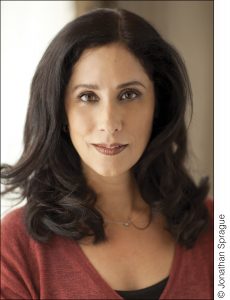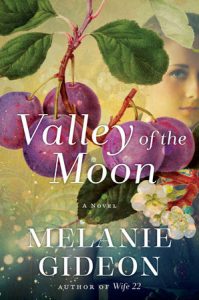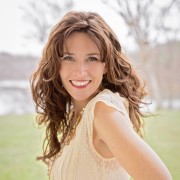Q&A with Melanie Gideon
Celebrated New York Times best-selling writer Melanie Gideon’s talent seems to translate to every genre. (Not jealous, not jealous…J) Her work includes young adult fantasy, memoire, adult contemporary, and with her latest, VALLEY OF THE MOON, she dips her toe into the pools of time-travel, magical realism, and historical fiction.
Her “Modern Love” column for The New York Times was adapted into THE SLIPPERY YEAR, a candid and comical mediation on the ups and downs of marriage and motherhood. The predecessor to Valley of the Moon was her first adult novel, WIFE 22 which was released in 30 different countries and acquired by Working Title films for the big screen. She has written for the New York Times, the San Francisco Chronicle, More, Shape, Marie Claire, the London Times, the Daily Mail and other publications. She lives in San Francisco with her husband and son.
We could not be more pleased to welcome Melanie to WomenWritersWomen[‘s]Books.
 Let’s start from the beginning, Melanie, your beginning.
Let’s start from the beginning, Melanie, your beginning.
Where did you grow up? How do you think that shaped who’ve you become?
I grew up in Rhode Island. My formative reading years (the years that made me into a writer) were spent in South County, R.I. We had horses, chickens and 12 acres of woods. The nearest neighbor was a few miles away so all I did was read and wander around the woods hoping I’d find a portal to Narnia. Newport, R.I. is featured in Valley of the Moon—my parents live there now.
What are your favorite television shows?
We’re in such a golden age of television—the storytelling is groundbreaking. Some of my recent favorites: Fargo, Crazy-Ex-Girlfriend, Transparent, Outlander, Game of Thrones, Fresh Off the Boat, Blackish, Catastrophe, Orange is the New Black, Walking Dead, House of Cards.
You’ve written in several genres. Do you have a favorite? Do they have different challenges? How do you keep your audience with you as you move between them?
My favorite is the genre of whatever book I’m currently writing. I get bored writing in one genre so I have to keep switching it up and I can only hope my audience is willing to come along with me.
As in the story of Brigadoon, which you’ve said was an inspiration for VALLEY OF THE MOON, a present day woman stumbles upon a mysterious village from post-earthquake 1906 San Francisco which appears intermittently and is separated further by time passing at different rates. In both stories a relationship develops between the present day character and a person from the elusive village. What was it like to write a story with an elastic timeline like that? What challenges did you find?
Valley of the Moon was the most challenging book I’ve ever written. In fact, I wrote the book once and then realized it was stillborn, so to speak, so I wrote a second completely different book. Same conceit, different approach. It was quite difficult to pull the time travel piece off, to organically integrate the supernatural element. Ultimately, the solution was to ground the book in character development. That’s usually the solution by the way.
Why did you choose 1906 and ‘the seventies’ San Francisco?
1906, because I wanted to use the famous earthquake of 1906 as the precipitating event that sets everything into motion, and the seventies because I came of age in the seventies. I have such nostalgia and love for that time period.
The main character of Valley, single mom Lux, had always been very close her father. One summer at their beloved family lake that changed. He had a secret, and she was growing up. That summer not only impacted her relationship with her dad but was inextricably entangled with her view of self as it evolved from adolescence to adulthood. You wrote this plotline with such depth and insight. How does a writer learn to observe at that level?
I think the first step is knowing your character really well. Who she is. Where she came from. Why she might do the things that she does. Her strengths. Her flaws. Her deepest wound and her biggest secret. Once you know those things the story flows organically.
You have a very diverse cast of characters in Valley by race and gender. Was this intentional?
Absolutely. That’s the world we live in and that’s the world I wanted to create.
The importance of email in the early stages of your courtship with your husband when you were separated by distance has been covered in The Guardian, The Everygirl, and Mediterrean OC. This was a time when most people didn’t have email accounts. How have you seen dating resources and rituals change since then? What do you think are the advantages and disadvantages of online communication to meet people and in dating?
Email seems so old-fashioned, so Jane Austen-ish now, doesn’t it? Since I’ve been married to the same person for 23 years, I’m not all that familiar with the current online dating/courtship scene. I do have a teenage son, however, and I’m both amazed and blown away at how complicated online communication has become. The texting dance you have to do when you like somebody. Everything matters. How long you wait until texting somebody back, to emoji or not emoji, to punctuate or not to punctuate—all of those decisions convey meaning and tone. It’s way too complicated for me.
Was that experience part of your inspiration for Wife 22?
Yes, definitely.
What have been the most impactful lessons on your storytelling and writing since your first, The Girl Who Swallowed the Moon?
Without a doubt—books! Read, read, read! Everything from Tom Clancy to Joan Didion to JoJo Moyes to Tolkien to Colson Whitehead to Roxane Gay. Fiction and non-fiction. The New Yorker and Gawker. High and low. Don’t be a snob. It’s all fodder.
Your writing hangs on an impeccable story structure. Each click of character growth is identifiable, compelling, and fathomable. I can only conclude that you are a plotter. Is this true? What tools do you find most helpful? What craft books or experts have had the most impact on your writing?
I’m a serious plotter and outliner. I never start a book until I have a comprehensive outline. And I usually know the ending of the book as well. Robert McKee’s Story: Style, Structure, Substance, and the Principals of Screenwriting has been hugely impactful for me. Although I’ve always had a natural writing bent, story architecture was something I had to learn and teach myself. I like to think I’ve gotten better at it with each book.
You’ve said that it took many years before you could support yourself with your writing, a situation most writers experience today, and you wrote most of your first book while you were at work, a situation many writers secretly cop to. We won’t tell. Shhhh… J Given how much writing it takes to reach the point of being ready for publishing, not to mention achieving a living wage with it, there is great pressure to write and only write, even we are fortunate to write full time. But we are wives, mothers, sisters, friends, and many of us do have other jobs. How do you balance your time? What have you learned or discovered about this resonant struggle?
What matters most is getting your butt in the chair on a regular basis. Whether your writing session is twenty minutes or three hours, the important thing is building a daily practice and making that commitment to yourself and your work.
Have you experience rejection in your career? Does it still happen? Does it get easier?
Of course! It goes with the territory. And it still stings and hurts every time. The bad reviews tend to stick with you forever while the good ones are like cotton candy—a momentary burst of sugar in the mouth but empty calories in the long run. I don’t know why it’s this way, but it is.
There is a comical video making the rounds right now of authors reading their bad reviews out loud. It is funny, healthy, and helpful to watch, but also, for empathetic hearts, it hurts. What is your relationship with your reviews? Do you read them? Is there something you wish you could say to reviewers?
See answer above.
How important are reviews for books today? Are all review sites equally influential – blogs, Amazon, goodreads, Litsy, Barnes & Noble, etc.?
A lot has changed since I published Wife 22 in 2012. Reviews in major outlets are still important, but the reviews and coverage that really seem to move the needle are blogs, literary websites, Goodreads etc. It’s become a much more democratic process. There’s such power in word of mouth.
Two Part Question: For readers — Where should readers hang out to interact with authors? For writers — What have you found most effective for reaching readers?
Readers—go to readings! Authors will be so happy to see your smiling faces in the audience, I promise you. I’m always so grateful to anybody who goes out of their way to attend a reading.
Writers—I suppose the ultimate way you reach a reader is by writing the best book you can.
Any other advice for writers who are still climbing the publishing mountain?
Don’t give up. For most people it’s a long road filled with rocky starts, blind turns, temblors and the occasional full-blown earthquake. Expect that to be the case. Sometimes I think the only reason I’m where I am is because every time I fall (and I fall a lot) I just keep getting back up.
Who are some of your favorite writers? Who should we be reading that we may not know about yet?
Lauren Groff, James Salter, Natalie Baszile, Octavia Butler, Justin Cronin, Kate Atkinson, Jhumpa Lahiri, Kelly Link and Michael Cunningham, to name a few.
And finally…
Favorite Rice a Roni blend? Cheddar-Broccoli
Favorite Ghiradhelli chocolate? Plain old milk chocolate
Favorite cheese shop? Cheese? The Cheese Board in Berkeley, Ca. La Tur—a pungent, runny cheese.
Favorite place for a mission-style burrito? La Taqueria in the Mission in SF.
Thank you, Melanie, so much for hanging out with us. Welcome to the WWWB family! We will be supporting and rooting for you forever more. ☺
 THE VALLEY OF THE MOON –
THE VALLEY OF THE MOON –
In this captivating novel from the author of Wife 22, a woman who feels lost in her own time stumbles across a California community that has, impossibly, been marooned in the early twentieth century perfect for readers of The Time Traveler’s Wife, Time and Again, and Sarah Addison Allen.
Lux is a single mom struggling to make her way when she discovers an idyllic community in the Sonoma Valley. It seems like a place from another time until she realizes it actually is. Lux must keep one foot in her world, raising her son as well as she can with the odds stacked against her, but every day she is more strongly drawn in by the sweet simplicity of life in Greengage, and by the irresistible connection she feels with a man born decades before her. Soon she finds herself torn between her ties to the modern world, her adored son and the first place she has ever felt truly at home.
Praise –
“The literary equivalent of a farm-to-table-delicacy: lovingly handcrafted, delectable and transcendent, becoming more than a just a tasty appetizer but a full-course experience of love and time…”
San Francisco Chronicle
“A wonderful story about belonging, love and the aching certainty that there’s something more out there.”
Starred review: Shelf Awareness
“A magic carpet ride back to an earlier time and a gentler place.” Kirkus
“Magical, cinematic . . . Valley of the Moon is breathlessly romantic and alive with the love of language.”—Sarah Addison Allen
VALLEY OF THE MOON is available –
Amazon Barnes & Noble Indiebound
Other ways to bond with Melanie Gideon –
Interviewed by –

MM Finck
MM Finck is a writer, essayist, and book reviewer. She oversees WWWB’s Interviews and Agents’ Corner segments. Her women’s fiction and is represented by Katie Shea Boutillier of the Donald Maass Literary Agency. She is a member of the Women’s Fiction Writers Association and the contest chair for the Women’s Fiction Writers Association 2016 Rising Star writing contest for unpublished authors. Her work has appeared in national and regional publications, including skirt! magazine.
When she isn’t editing her novel, #LOVEIN140, you can find her belting out Broadway tunes (off key and with the wrong words), cheering herself hoarse over a soccer match (USWNT! – 2015 WORLD CUP CHAMPIONS!!!!), learning to play piano (truly pitifully), building or fixing household things, and trying to squeeze more than twenty-four hours out of every day. She is active on Facebook, Twitter, Goodreads, Li.st (@MMFinck), and Litsy (@MMF). http://www.mmfinck.com
Category: Interviews























